Cityscape LoRa Signal Propagation Predicted and Tested Using Real-World Building-Data Based O-FDTD Simulations and Experimental Characterization
Abstract
1. Introduction and Related Work
2. Related Work
3. Materials and Methods
3.1. LoRa System Signal Coverage-Characterization
3.1.1. Materials
3.1.2. Methods
3.2. O-FDTD Simulation of LoRa Coverage
4. Results
4.1. Free Space Path Loss (FSPL) Model and Receiver Sensitivity
4.2. O-FDTD for Spatially Resolved LoRa Signal Propagation Simulation
4.3. Experimental Characterization of LoRa Coverage
4.4. Analysis of Simulation Versus Experimental Results
5. Discussion
- (1)
- Implementation and impact of cars and trees: Apart from path loss models specifically developed to account for trees [25], which require knowledge of tree parameters such as spatial distribution, leaf area index, and trunk diameter, most approaches use semi-empirical methods to determine an average path loss characteristic of the city in question [20]. We do not do this in our approach but instead use the building walls arrangement of a real-world city map directly. We remark that trees are sparse in this particular area of the campus, and cars do not entirely block the signal propagation above 2 m from the ground. Nevertheless, future works beyond this proof-of-concept could, in areas containing denser distributions of such scattering objects, include a map of trees or additional scattering elements assigned to specific regions where cars or trees are known to be abundant. The accurate location of trees may, for example, be obtainable from satellite images from Google Maps using some dedicated image processing algorithm. Such additional elements would be treated in the O-FDTD method analogously to the way building walls were treated in this work.
- (2)
- Absence of terrain and weather data: As a 2D wave propagation method, O-FDTD does not trivially take terrain information into account. Future study could be envisioned to investigate how a modified O-FDTD approach, e.g., via dielectric permittivity gradients, could model terrain features. However, the topography should not significantly impact the area considered in this work since this is usually only considered for far more extended regions [44]. Previous works describe the influence of weather parameters in LoRa propagation [61]. Again due to the area contemplated, relevant air temperature gradients across the considered cityscape can be disregarded. A more refined approach could take into account shades cast by tall buildings in sunny countries. However, additional information on the building height would be required, and the shade regions vary with the hour of the day. Thus, a linear correction to the RSSI maps could be considered to account for the average temperature, following previously identified dependences of the signal-coverage on weather parameters.
- (3)
- (4)
- Indoor LoRa signal distribution: the concrete walls can be considered the dominant source of damping and reflection, not only because concrete is a very absorbent material in itself but also because walls represent full floor-to-ceiling barriers, while furniture items, aside from impossible to determine, are only partial barriers, thus allowing most of the signal to diffract around them. On the one hand, we consider all building walls as made of concrete and therefore ignore far less absorbent glass windows. This is a reasonable approximation since concrete is the predominant building material. On the other hand, one could argue that the exaggerated wall absorption may somehow compensate for the absence of furniture, even though the scattering features would be slightly different.
- (5)
- Use of a single permittivity value: At a glance, this could be a significant error source since considering a single permittivity may overlook highly scattering materials such as metals. However, we are interested in modeling radiation-matter interactions, mainly in terms of reflection and absorption by building walls. In the RF regime, the dielectric properties of metals are dominated by their electrical conductivity, leading to a virtually infinite permittivity, making them almost perfect mirrors. In this work, we used a dielectric permittivity value estimated to reproduce the absorption of about 50 dB/m. Hence, the associated contrast in the dielectric permittivity, or equivalent refractive index, leads to a reflectance of about 20% for normal incidence, which is not a very good approximation for metallic surfaces. The O-FDTD method can reproduce the metallic mirror behavior via the use of arbitrarily large refractive index values e.g., r(n = 100) = 96%, r(n = 200) = 98%, which is similar to previously reported approaches using knife-edge methods [35]. However, to accurately incorporate the cityscape contributions of metals would require a much more complete representation of the cityscape, containing the mapping of metals within the building walls. Considering this level of detail might be feasible for small-scale indoor applications, but it is not practical in the cityscape scope. Instead, we assumed that walls are dominantly composed of concrete, with a common permittivity. Alternatively, one could incorporate the effects of metals within the wall structures by increasing the real part of the refractive index to induce a higher reflectance, which could approximate the average metal composition in building materials, provided that information is available.
6. Conclusions and Outlook
Supplementary Materials
Author Contributions
Funding
Institutional Review Board Statement
Informed Consent Statement
Data Availability Statement
Conflicts of Interest
References
- Centenaro, M.; Vangelista, L.; Zanella, A.; Zorzi, M. Long-range communications in unlicensed bands: The rising stars in the IoT and smart city scenarios. IEEE Wirel. Commun. 2016, 23, 60–67. [Google Scholar] [CrossRef]
- Raza, U.; Kulkarni, P.; Sooriyabandara, M. Low Power Wide Area Networks: An Overview. IEEE Commun. Surv. Tutor. 2017, 19, 855–873. [Google Scholar] [CrossRef]
- LoRa Alliance LoRaWAN 1.1 Specification 2017, 101. Available online: https://lora-alliance.org/resource_hub/lorawan-specification-v1-1/ (accessed on 4 April 2021).
- Tome, M.D.C.; Nardelli, P.H.J.; Alves, H. Long-Range Low-Power Wireless Networks and Sampling Strategies in Electricity Metering. IEEE Trans. Ind. Electron. 2018, 66, 1629–1637. [Google Scholar] [CrossRef]
- Ahlers, D.; Driscoll, P.; Kraemer, F.; Anthonisen, F.; Krogstie, J. A Measurement-Driven Approach to Understand Urban Greenhouse Gas Emissions in Nordic Cities. In Proceedings of the NIK-2016 Conference, Bergen, Norway, 28–30 November 2016. [Google Scholar]
- Orfei, F.; Mezzetti, C.B.; Cottone, F. Vibrations powered LoRa sensor: An electromechanical energy harvester working on a real bridge. In Proceedings of the 2016 IEEE SENSORS, Orlando, FL, USA, 30 October–3 November 2016; pp. 1–3. [Google Scholar]
- Yang, F.; Ramachandran, G.S.; Lawrence, P.; Michiels, S.; Joosen, W.; Hughes, D. μPnP-WAN: Wide area plug and play sensing and actuation with LoRa. In Proceedings of the 2016 International SoC Design Conference (ISOCC), Jeju, Korea, 23–26 October 2016; pp. 225–226. [Google Scholar]
- Augustin, A.; Yi, J.; Clausen, T.; Townsley, W.M. A Study of LoRa: Long Range & Low Power Networks for the Internet of Things. Sensors 2016, 16, 1466. [Google Scholar] [CrossRef]
- Khutsoane, O.; Isong, B.; Abu-Mahfouz, A.M. IoT devices and applications based on LoRa/LoRaWAN. In Proceedings of the IECON 2017—43rd Annual Conference of the IEEE Industrial Electronics Society, Beijing, China, 29 October–1 November 2017; pp. 6107–6112. [Google Scholar]
- Talla, V.; Hessar, M.; Kellogg, B.; Najafi, A.; Smith, J.R.; Gollakota, S. Lora backscatter: Enabling the vision of ubiquitous connectivity. Proc. ACM Interact. Mobile Wearable Ubiquitous Technol. 2017, 1, 1–24. [Google Scholar] [CrossRef]
- Peng, Y.; Shangguan, L.; Hu, Y.; Qian, Y.; Lin, X.; Chen, X.; Fang, D.; Jamieson, K. PLoRa: A passive long-range data network from ambient LoRa transmissions. In Proceedings of the 2018 Conference of the ACM Special Interest Group on Data Communication, London, UK, 20–25 August 2018; pp. 147–160. [Google Scholar]
- Pham, C. Robust CSMA for long-range LoRa transmissions with image sensing devices. In Proceedings of the 2018 Wireless Days, Dubai, United Arab Emirates, 3–5 April 2018; pp. 116–122. [Google Scholar] [CrossRef]
- Adão, R.; Caño-García, M.; Maibohm, C.; Nieder, J. Photonic polymeric structures and electrodynamics simulation method based on a coupled Oscillator Finite-Difference Time-Domain (O-FDTD) approach. Opt. Express 2021. [Google Scholar] [CrossRef]
- Liang, R.; Zhao, L.; Wang, P. Performance Evaluations of LoRa Wireless Communication in Building Environments. Sensors 2020, 20, 3828. [Google Scholar] [CrossRef] [PubMed]
- Bertoldo, S.; Paredes, M.; Carosso, L.; Allegretti, M.; Savi, P. Empirical indoor propagation models for LoRa radio link in an office environment. In Proceedings of the 13th European Conference on Antennas and Propagation (EuCAP), Krakow, Poland, 31 March–5 April 2019; pp. 1–5. [Google Scholar]
- Xu, W.; Kim, J.Y.; Huang, W.; Kanhere, S.S.; Jha, S.K.; Hu, W. Measurement, Characterization, and Modeling of LoRa Technology in Multifloor Buildings. IEEE Internet Things J. 2019, 7, 298–310. [Google Scholar] [CrossRef]
- Rathod, N.; Jain, P.; Subramanian, R.; Yawalkar, S.; Sunkenapally, M.; Amrutur, B.; Sundaresan, R. Performance analysis of wireless devices for a campus-wide IoT network. In Proceedings of the 2015 13th International Symposium on Modeling and Optimization in Mobile Ad Hoc and Wireless Networks (WiOpt), Mumbai, India, 25–29 May 2015; pp. 84–89. [Google Scholar] [CrossRef]
- Lee, H.-C.; Ke, K.-H. Monitoring of Large-Area IoT Sensors Using a LoRa Wireless Mesh Network System: Design and Evaluation. IEEE Trans. Instrum. Meas. 2018, 67, 2177–2187. [Google Scholar] [CrossRef]
- Amadou, I.; Foubert, B.; Mitton, N. LoRa in a haystack: A study of the LORA signal behavior. In Proceedings of the 2019 International Conference on Wireless and Mobile Computing, Networking and Communications (WiMob), Barcelona, Spain, 21–23 October 2019; pp. 1–4. [Google Scholar] [CrossRef]
- Eremin, V.; Borisov, A. A research of the propagation of LoRa signals at 433 and 868 MHz in difficult urban conditions. IOP Conf. Series Mater. Sci. Eng. 2018, 363, 012014. [Google Scholar] [CrossRef]
- Gilson, R.; Grudsky, M. LoRaWAN Capacity Trial in Dense Urban Environment. 2017. Available online: https://www.smart-city-solutions.de/wp-content/uploads/2018/04/machineQ_LoRaWan_Capacity_Trial.pdf (accessed on 4 April 2020).
- Linka, H.; Rademacher, M.; Aliu, O.G.; Jonas, K.; Rhein-sieg, B.; Augustin, S. Path Loss Models for Low-Power Wide-Area Networks: Experimental Results using LoRa. In Proceedings of the VDE ITG-Fachbericht Mobilkommunikation, Osnabrück, Germany, 15–16 May 2018. [Google Scholar]
- Grion, F.J.; Petracca, G.O.; Lipuma, D.F.; Amigo, E.R. LoRa network coverage evaluation in urban and densely urban enviroment simulation and validation tests in Autonomous City of Buenos Aires. In Proceedings of the 2017 XVII Workshop on Information Processing and Control (RPIC), Mar del Plata, Argentina, 20–22 September 2017; pp. 1–5. [Google Scholar] [CrossRef]
- Bezerra, N.S.; Ahlund, C.; Saguna, S.; De Sousa, V.A. Propagation Model Evaluation for LoRaWAN: Planning Tool versus Real Case Scenario. In Proceedings of the 2019 IEEE 5th World Forum on Internet of Things (WF-IoT) 2019, Limerick, Ireland, 15–18 April 2019; pp. 1–6. [Google Scholar] [CrossRef]
- Wu, Y.; Guo, G.; Tian, G.; Liu, W. A Model with Leaf Area Index and Trunk Diameter for LoRaWAN Radio Propagation in Eastern China Mixed Forest. J. Sens. 2020, 2020, 1–16. [Google Scholar] [CrossRef]
- Haslett, C.; Webb, W.; Dixit, S. (Eds.) Essentials of Wave Propagation; Cambridge University Press: Cambridge, UK, 2008; ISBN 9780521875653. [Google Scholar]
- Hosseinzadeh, S.; Larijani, H.; Curtis, K.; Wixted, A.; Amini, A. Empirical propagation performance evaluation of LoRa for indoor environment. In Proceedings of the 2017 IEEE 15th International Conference on Industrial Informatics (INDIN), Emden, Germany, 24–26 July 2017; pp. 26–31. [Google Scholar]
- Miao, W.; Yin, J.; Jiang, C.; Wei, L.; Chen, X.; Guo, B.; Li, W.; Liu, R.; Yu, J.; Ye, W. Coverage Analysis in TD-LTE Wireless Private Networks for Power Systems: A 3D Ray-Tracing Approach. In Proceedings of the 2018 IEEE International Conference on Big Data and Smart Computing (BigComp), Shanghai, China, 15–17 January 2018; pp. 155–162. [Google Scholar]
- Pathak, P.H.; Carluccio, G.; Albani, M. The Uniform Geometrical Theory of Diffraction and Some of Its Applications. IEEE Antennas Propag. Mag. 2013, 55, 41–69. [Google Scholar] [CrossRef]
- Ozgun, O. New Software Tool (GO+UTD) for Visualization of Wave Propagation [Testing Ourselves]. IEEE Antennas Propag. Mag. 2016, 58, 91–103. [Google Scholar] [CrossRef]
- Firdaus, F.; Ahmad, N.A.; Sahibuddin, S. Accurate Indoor-Positioning Model Based on People Effect and Ray-Tracing Propagation. Sensors 2019, 19, 5546. [Google Scholar] [CrossRef] [PubMed]
- Froiz-Míguez, I.; Lopez-Iturri, P.; Fraga-Lamas, P.; Celaya-Echarri, M.; Blanco-Novoa, Ó.; Azpilicueta, L.; Falcone, F.; Fernández-Caramés, T.M. Design, Implementation, and Empirical Validation of an IoT Smart Irrigation System for Fog Computing Applications Based on LoRa and LoRaWAN Sensor Nodes. Sensors 2020, 20, 6865. [Google Scholar] [CrossRef] [PubMed]
- Zang, J.; Wang, X. Measurements and Modeling of Path Loss over Irregular Terrain for Near-Ground and Short-Range Communications. Prog. Electromagn. Res. M 2017, 57, 55–62. [Google Scholar] [CrossRef]
- P.526.11, R.I.-R. Propagation by Diffraction. Int. Telecommun. Union. 2018. Available online: https://www.itu.int/rec/R-REC-P.526-15-201910-I/en (accessed on 4 April 2021).
- Vavilov, S.A.; Lytaev, M.S. Modeling Equation for Multiple Knife-Edge Diffraction. IEEE Trans. Antennas Propag. 2020, 68, 3869–3877. [Google Scholar] [CrossRef]
- Zhu, N.Y.; Landstorfer, F.M. Numerical determination of diffraction, slope-, and multiple-diffraction coefficients of impedance wedges by the method of parabolic equation: Space waves. IEEE Trans. Antennas Propag. 1995, 43, 1429–1435. [Google Scholar]
- Ozgun, O. Recursive Two-Way Parabolic Equation Approach for Modeling Terrain Effects in Tropospheric Propagation. IEEE Trans. Antennas Propag. 2009, 57, 2706–2714. [Google Scholar] [CrossRef]
- El Ahdab, Z.; Akleman, F. Radiowave Propagation Analysis with a Bidirectional Three-Dimensional Vector Parabolic Equation Method. IEEE Trans. Antennas Propag. 2017, 65, 1. [Google Scholar] [CrossRef]
- Wang, R.; Lu, G.; Zhang, R.; Xu, W. Combination of the Improved Diffraction Nonlocal Boundary Condition and Three-Dimensional Wide-Angle Parabolic Equation Decomposition Model for Predicting Radio Wave Propagation. Int. J. Antennas Propag. 2017, 2017, 1–10. [Google Scholar] [CrossRef] [PubMed]
- Martelly, R.; Janaswamy, R. Modeling Radio Transmission Loss in Curved, Branched and Rough-Walled Tunnels with the ADI-PE Method. IEEE Trans. Antennas Propag. 2010, 58, 2037–2045. [Google Scholar] [CrossRef]
- Hata, M. Empirical formula for propagation loss in land mobile radio services. IEEE Trans. Veh. Technol. 1980, 29, 317–325. [Google Scholar] [CrossRef]
- Longley, A.G.; Rice, P. Prediction of Tropospheric Radio Transmission Loss over Irregular Terrain. A Computer Method-1968; NTIA Technical Report ERL 79-ITS 67; Institute for Telecommunication Sciences: Boulder, CO, USA, 1968. [Google Scholar]
- Seybold, J.S. Introduction to RF Propagation; Wiley: Hoboken, NJ, USA, 2005. [Google Scholar]
- Shumate, S.E. Longley-Rice and ITU-P.1546 Combined: A New International Terrain-Specific Propagation Model. In Proceedings of the 2010 IEEE 72nd Vehicular Technology Conference, Ottawa, ON, Canada, 6–9 September 2010; pp. 1–5. [Google Scholar] [CrossRef]
- Lytaev, M.; Borisov, E.; Vladyko, A. V2I Propagation Loss Predictions in Simplified Urban Environment: A Two-Way Parabolic Equation Approach. Electronics 2020, 9, 2011. [Google Scholar] [CrossRef]
- Song, Y.; Akoglu, A. Parallel Implementation of the Irregular Terrain Model (ITM) for Radio Transmission Loss Prediction Using GPU and Cell BE Processors. IEEE Trans. Parallel Distrib. Syst. 2011, 22, 1276–1283. [Google Scholar] [CrossRef]
- Jin, J. The Finite Element Method in Electromagnetics, 2nd ed.; John Wiley & Sons, Inc.: New York, NY, USA, 2002; ISBN 0-471-43818-9. [Google Scholar]
- Bieniasz, L.K. Numerical Solution Methods. Underpotential Depos. 2015, 14, 269–304. [Google Scholar] [CrossRef]
- Yu, W.; Yang, X.; Liu, Y.; Mittra, R. Electromagnetic Simulation Techniques Based on the FDTD Method, 1st ed.; John Wiley & Sons, Inc.: New Jersey, NJ, USA, 2009; ISBN 978-0-470-50203-7. [Google Scholar]
- Bogdanovich, I. Geo Tracker—GPS Tracker. Available online: https://play.google.com/store/apps/details?id=com.ilyabogdanovich.geotracker&hl=en (accessed on 18 September 2019).
- Google Maps City Map of Ourense. Available online: https://goo.gl/maps/ajVefXngCE6dHap96 (accessed on 6 January 2019).
- Sato, K.; Manabe, T.; Polivka, J.; Ihara, T.; Kasashima, Y.; Yamaki, K. Measurement of the complex refractive index of concrete at 57.5 GHz. IEEE Trans. Antennas Propag. 1996, 44, 35–40. [Google Scholar] [CrossRef]
- Stavrou, S. Review of constitutive parameters of building materials. In Proceedings of the Twelfth International Conference on Antennas and Propagation (ICAP 2003), Exeter, UK, 31 March–3 April 2003; Volume 2003, pp. 211–215. [Google Scholar]
- Semtech LoRa Modulation Basics AN1200.22. 2015. Available online: https://www.frugalprototype.com/wp-content/uploads/2016/08/an1200.22.pdf (accessed on 20 September 2019).
- Techplayon LoRa Link-Budget and Sensitivity Calculations. Available online: http://www.techplayon.com/lora-link-budget-sensitivity-calculations-example-explained/ (accessed on 7 October 2019).
- Robert, A. Dielectric permittivity of concrete between 50 Mhz and 1 Ghz and GPR measurements for building materials evaluation. J. Appl. Geophys. 1998, 40, 89–94. [Google Scholar] [CrossRef]
- Suwalak, R.; Phongcharoenpanich, C.; Torrungrueng, D.; Krairiksh, M. Determination of Dielectric Property of Construction Material Products Using a Novel Rfid Sensor. Prog. Electromagn. Res. 2012, 130, 601–617. [Google Scholar] [CrossRef]
- Stute, S.; Welzbacher, M. LoRaWAN-Range, Part 1: The Most Important Factors for a Good LoRaWan Radio Range. Available online: https://smartmakers.io/en/lorawan-range-part-1-the-most-important-factors-for-a-good-lorawan-signal-range/ (accessed on 25 March 2021).
- The Things Network LoRaWAN® Distance World Record Broken, Twice. 766 km (476 Miles) Using 25mW Transmission Power. Available online: https://www.thethingsnetwork.org/article/lorawan-distance-world-record/ (accessed on 14 January 2020).
- Tan, Z.; Rahman, M.T.; Rahman, A.; Hamid, A.F.; Amin, N.A.M.; Munir, H.; Zabidi, M.M.M. Analysis on LoRa RSSI in Urban, Suburban, and Rural Area for Handover Signal Strength-Based Algorithm. IOP Conf. Ser. Mater. Sci. Eng. 2019, 705, 012012. [Google Scholar] [CrossRef]
- Bezerra, N.S.; Åhlund, C.; Saguna, S.; de Sousa, V.A. Temperature Impact in LoRaWAN—A Case Study in Northern Sweden. Sensors 2019, 19, 4414. [Google Scholar] [CrossRef]
- Haedrich, C.E.; Breton, D.J.; Wilson, D.K. Isarithmic Mapping of Radio-Frequency Noise in the Urban Environment, ERDC/CRREL MP-20-12; ERDC/CRREL: Hanover, NH, USA, 2020. [CrossRef]
- Qin, Z.; Liu, Y.; Li, G.Y.; McCann, J.A. Performance Analysis of Clustered LoRa Networks. IEEE Trans. Veh. Technol. 2019, 68, 7616–7629. [Google Scholar] [CrossRef]
- ElSawy, H.; Hossain, E.; Haenggi, M. Stochastic Geometry for Modeling, Analysis, and Design of Multi-Tier and Cognitive Cellular Wireless Networks: A Survey. IEEE Commun. Surv. Tutor. 2013, 15, 996–1019. [Google Scholar] [CrossRef]
- Azpilicueta, L.; Rawat, M.; Rawat, K.; Ghannouchi, F.M.; Falcone, F. A Ray Launching-Neural Network Approach for Radio Wave Propagation Analysis in Complex Indoor Environments. IEEE Trans. Antennas Propag. 2014, 62, 2777–2786. [Google Scholar] [CrossRef]
- Gao, Y.; Shao, Q.; Yan, B.; Li, Q.; Guo, S. Parabolic Equation Modeling of Electromagnetic Wave Propagation over Rough Sea Surfaces. Sensors 2019, 19, 1252. [Google Scholar] [CrossRef] [PubMed]
- Choi, W.; Chang, Y.-S.; Jung, Y.; Song, J. Low-Power LoRa Signal-Based Outdoor Positioning Using Fingerprint Algorithm. ISPRS Int. J. Geo-Inf. 2018, 7, 440. [Google Scholar] [CrossRef]
- Cattani, M.; Boano, C.A.; Römer, K. An Experimental Evaluation of the Reliability of LoRa Long-Range Low-Power Wireless Communication. J. Sens. Actuator Netw. 2017, 6, 7. [Google Scholar] [CrossRef]
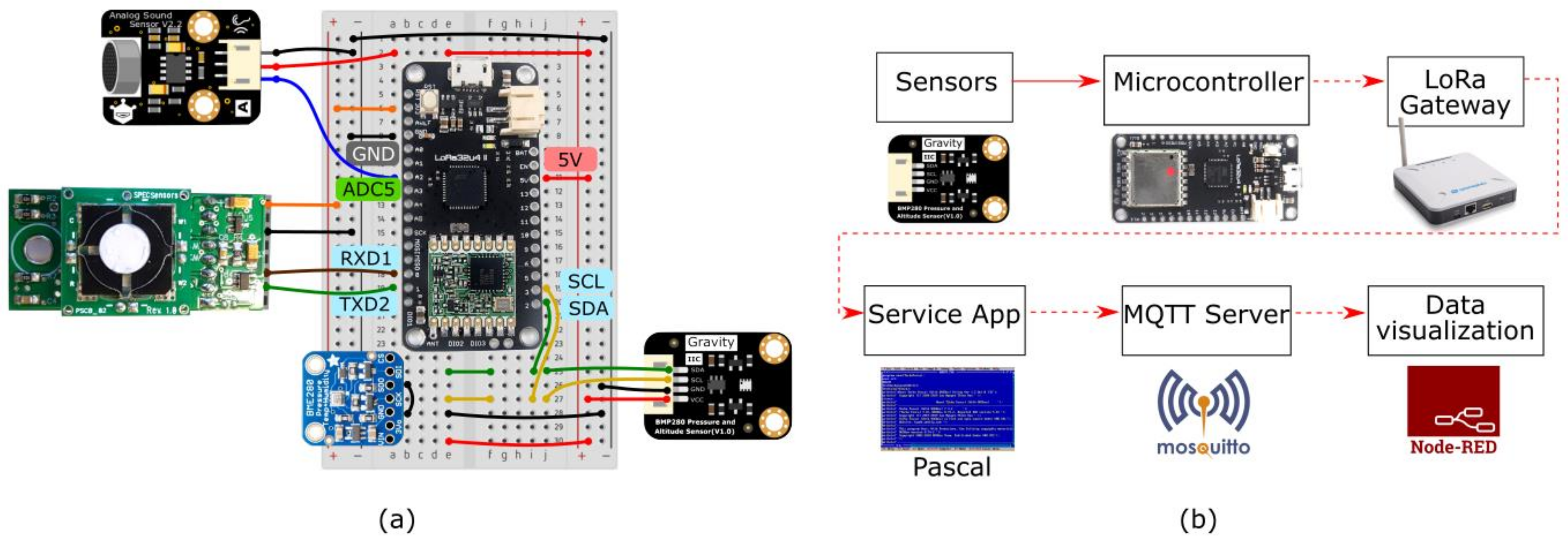
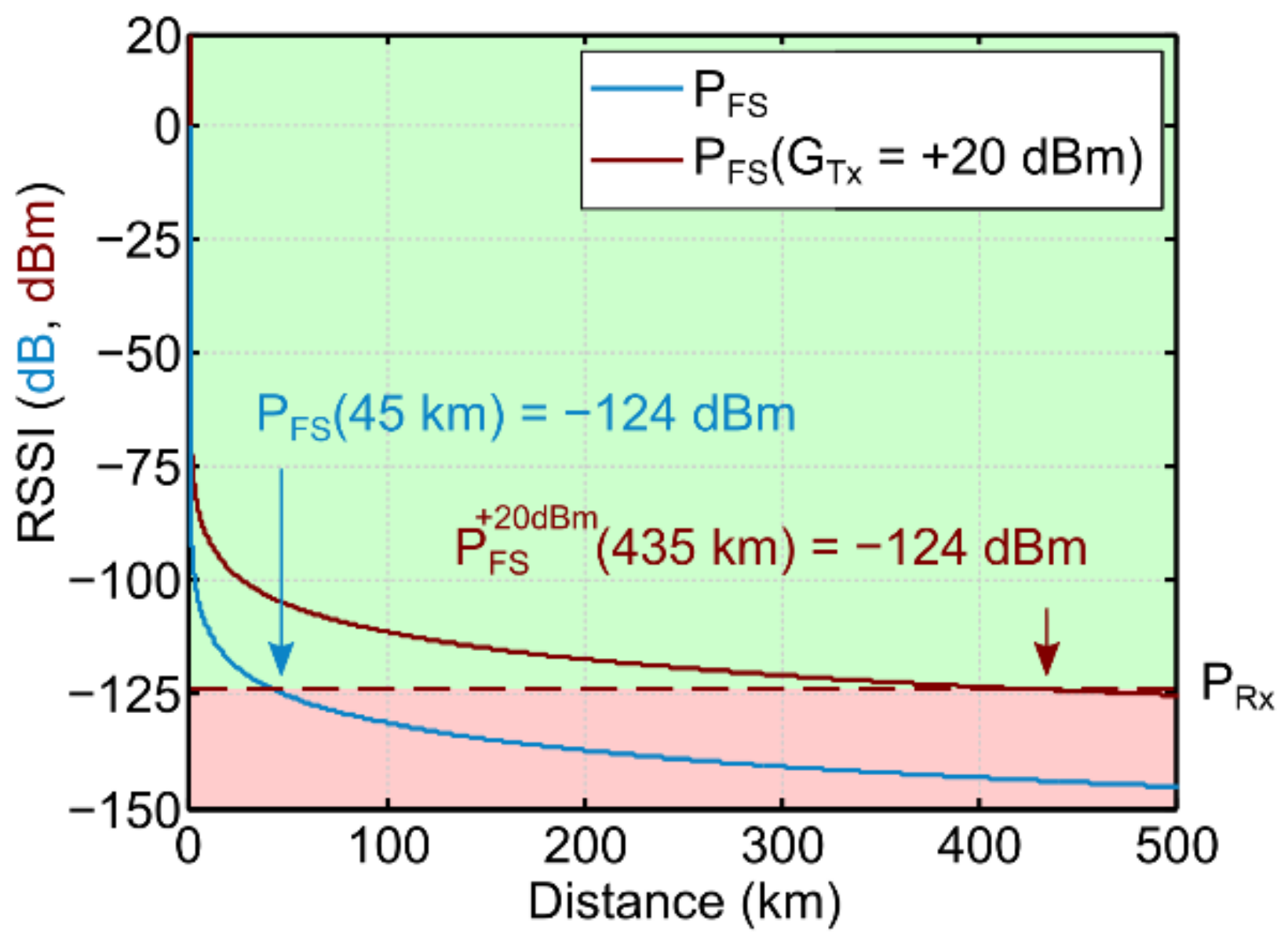
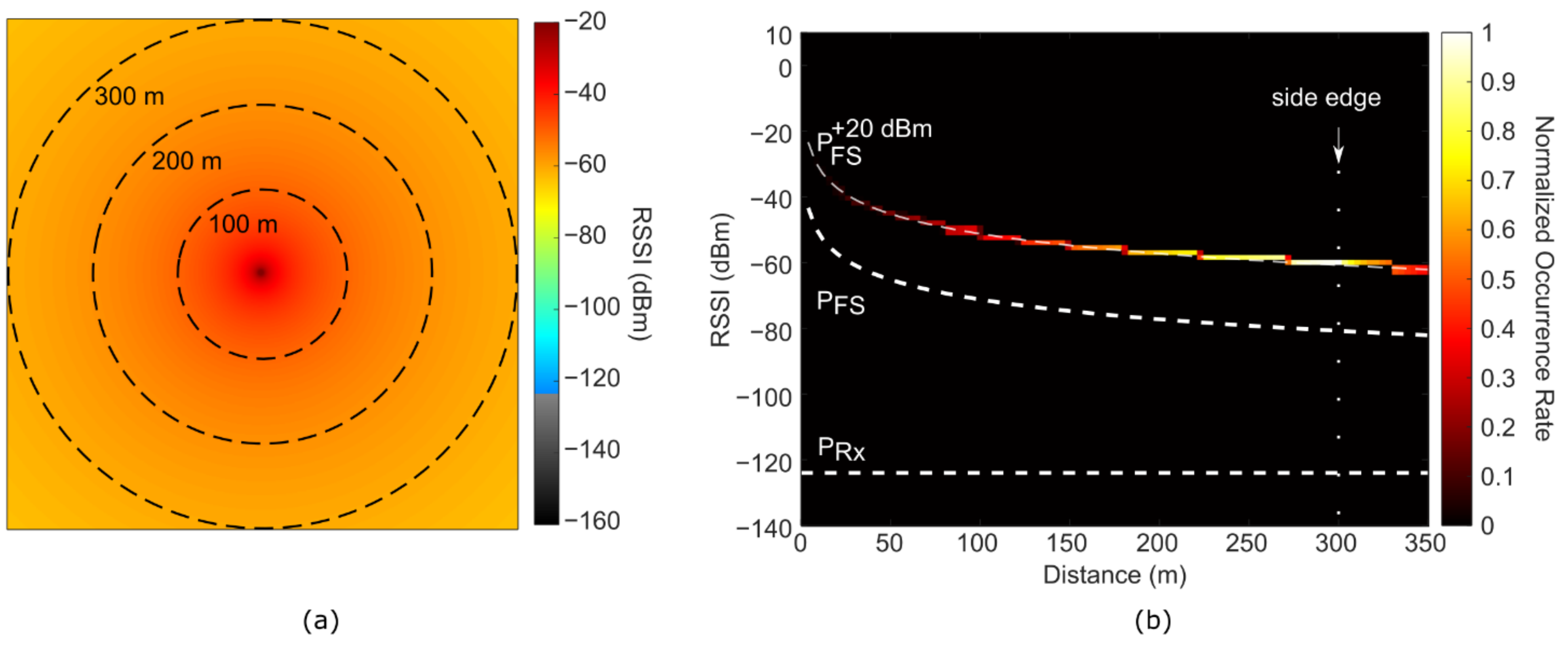
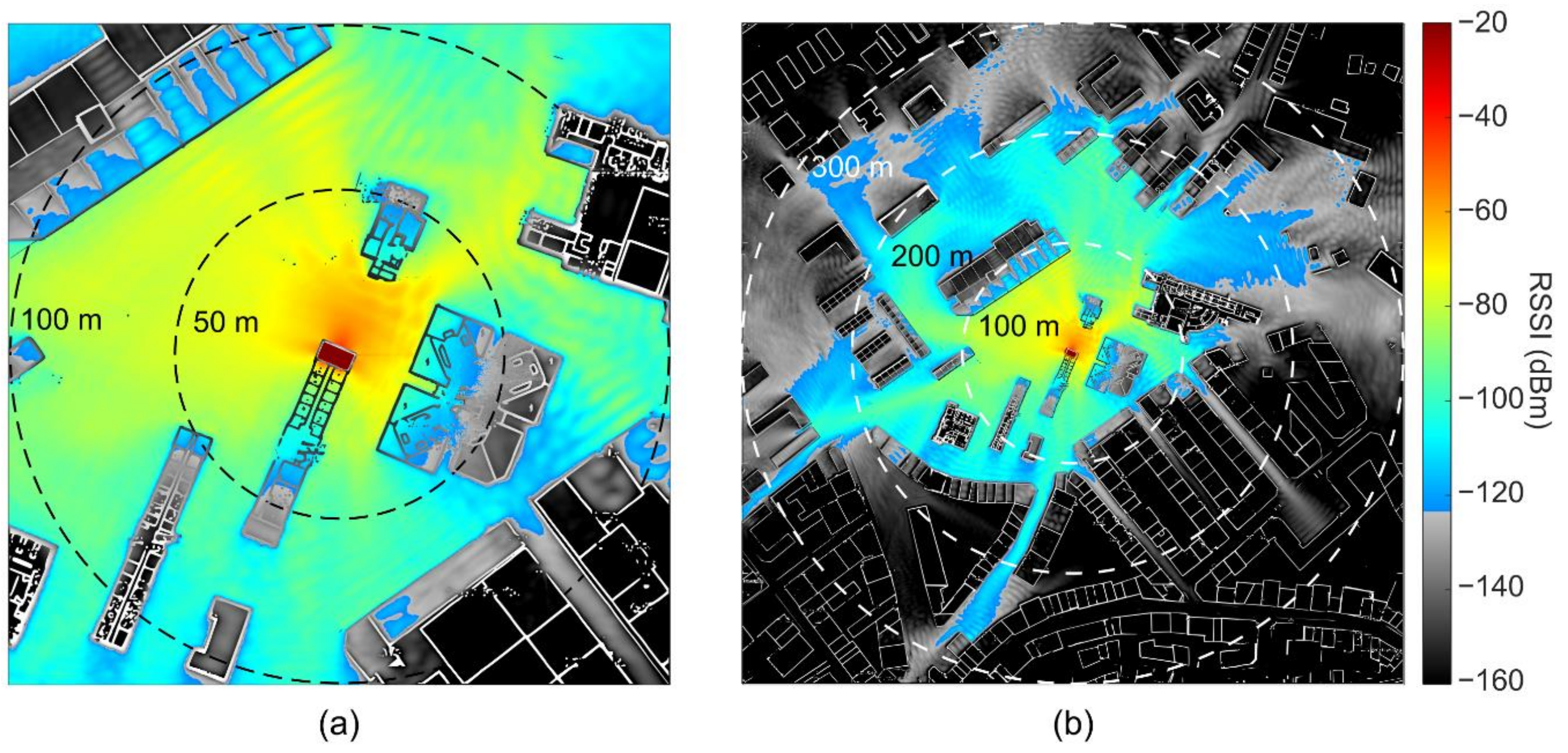
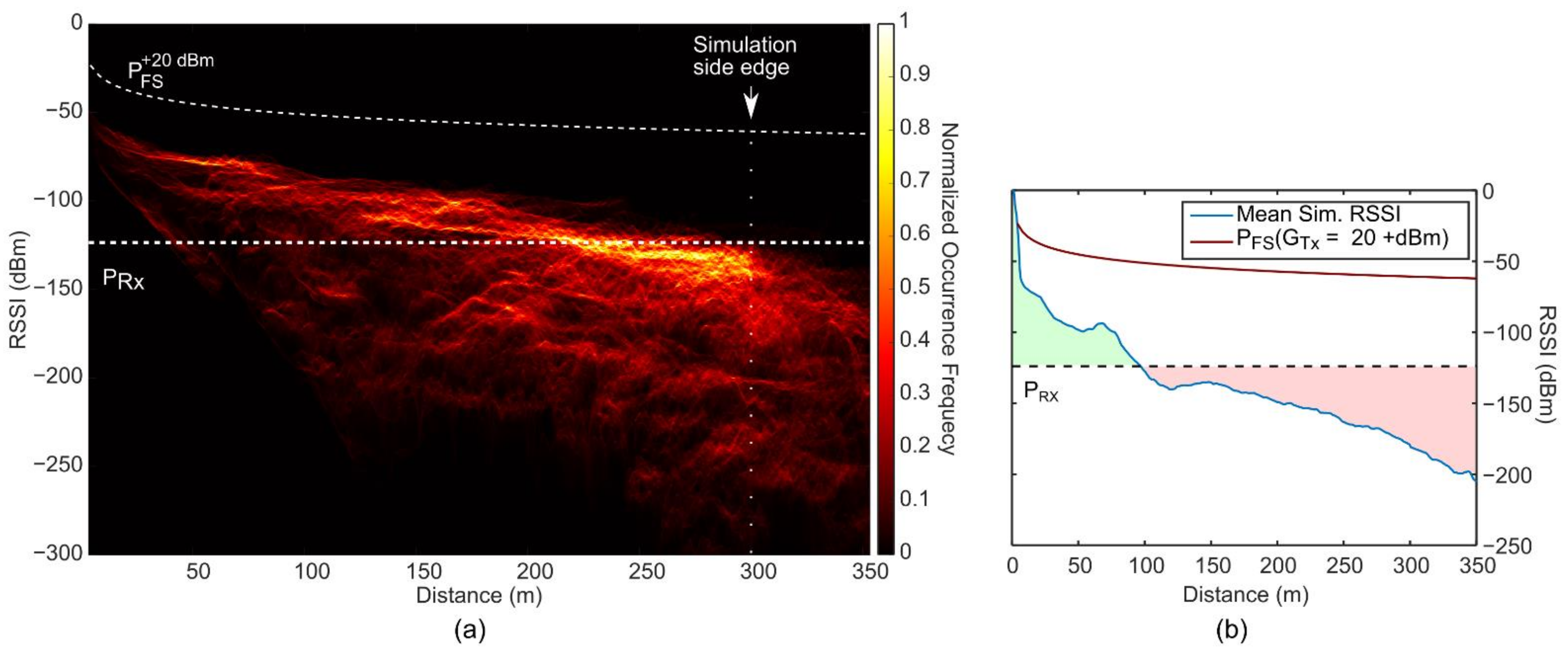
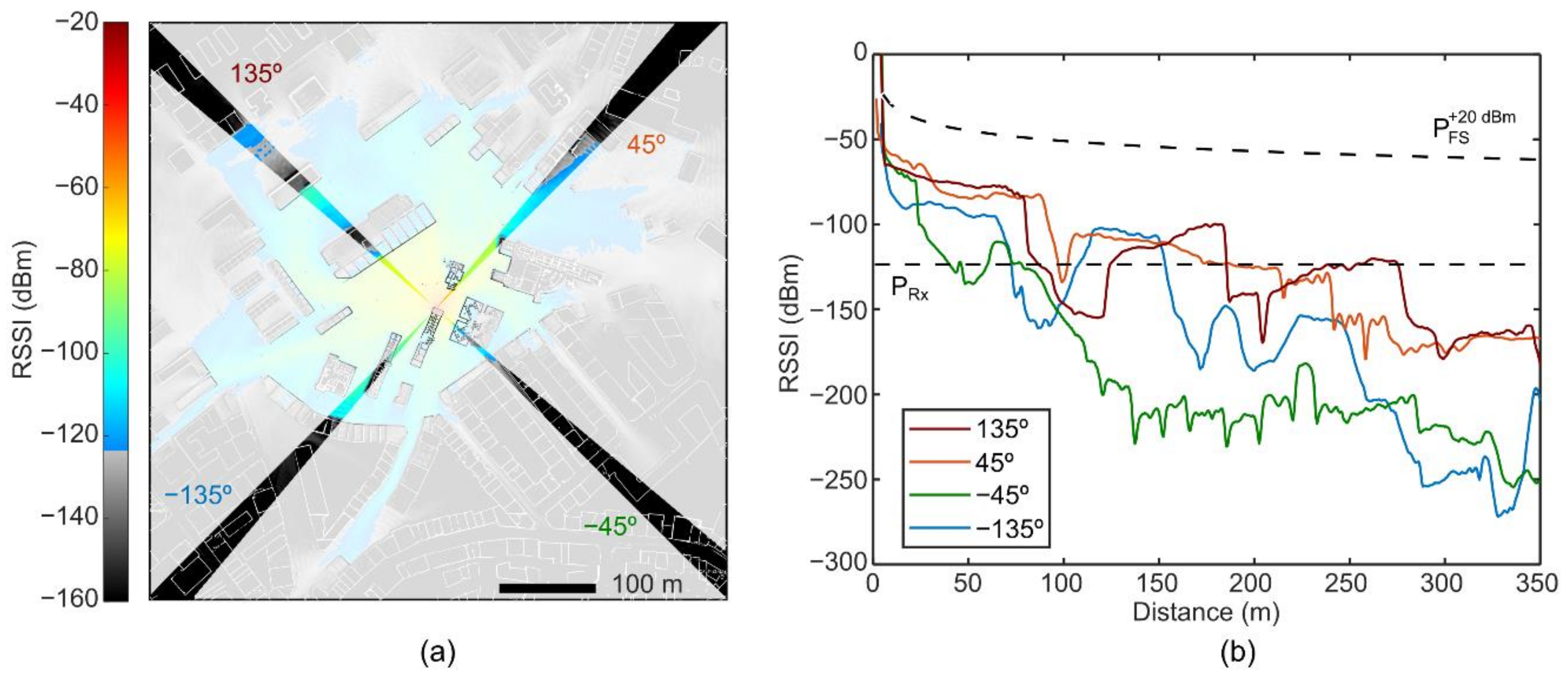
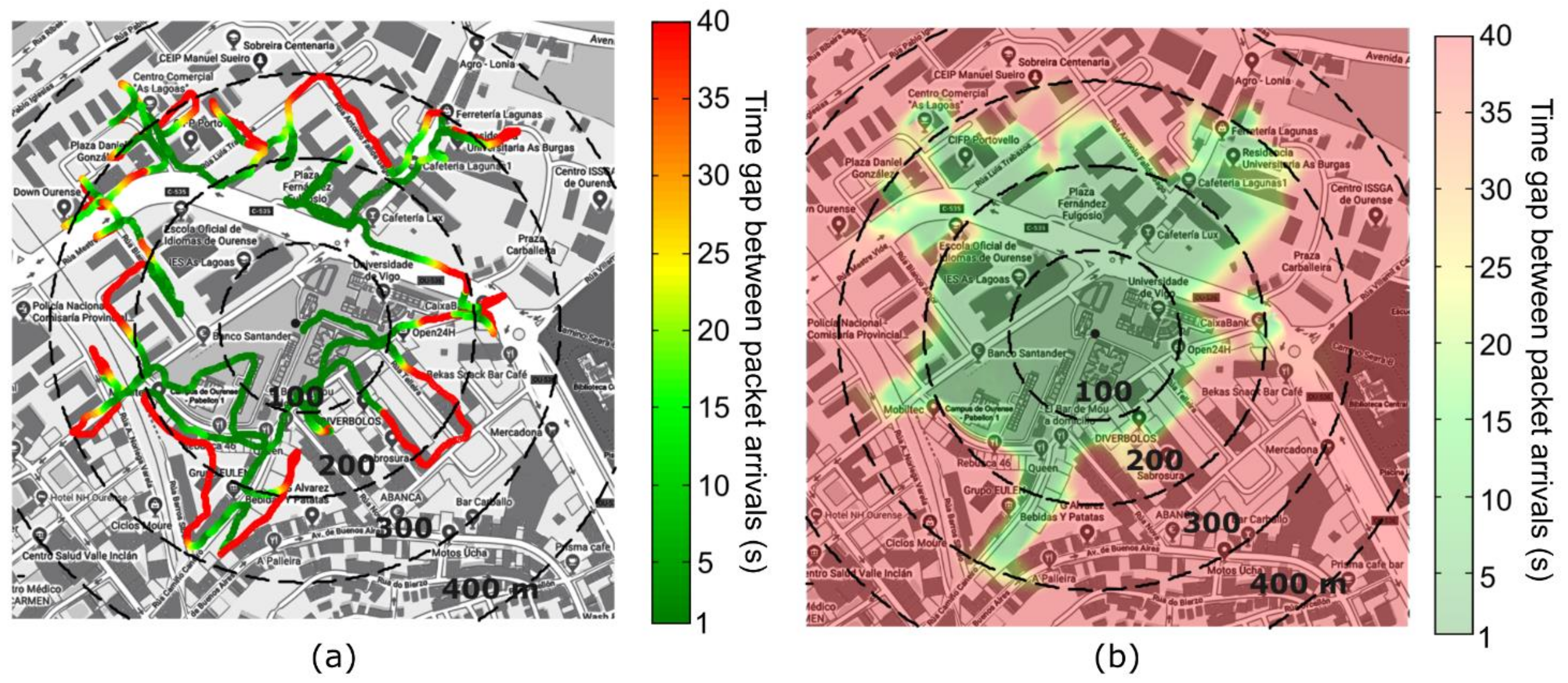
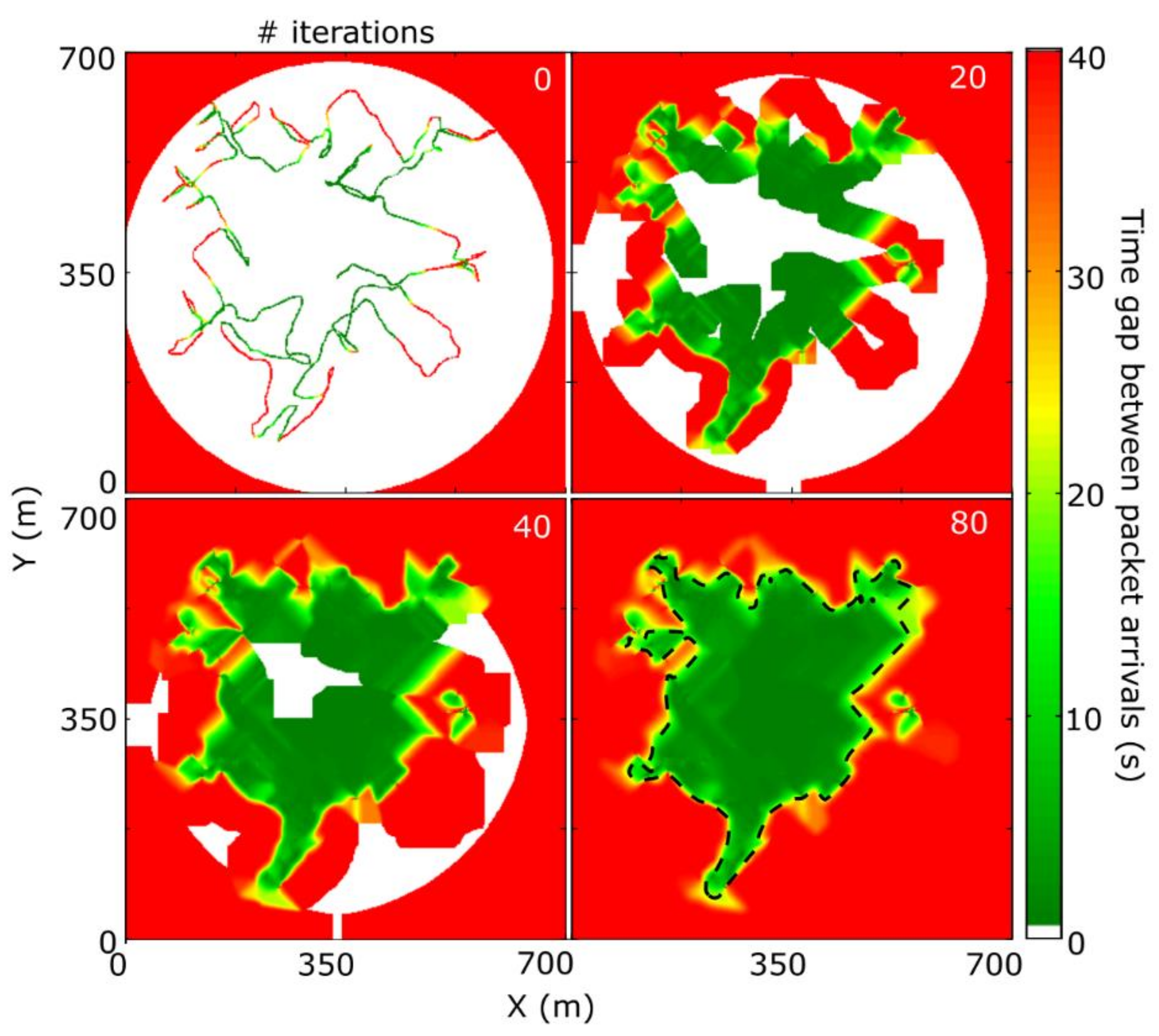
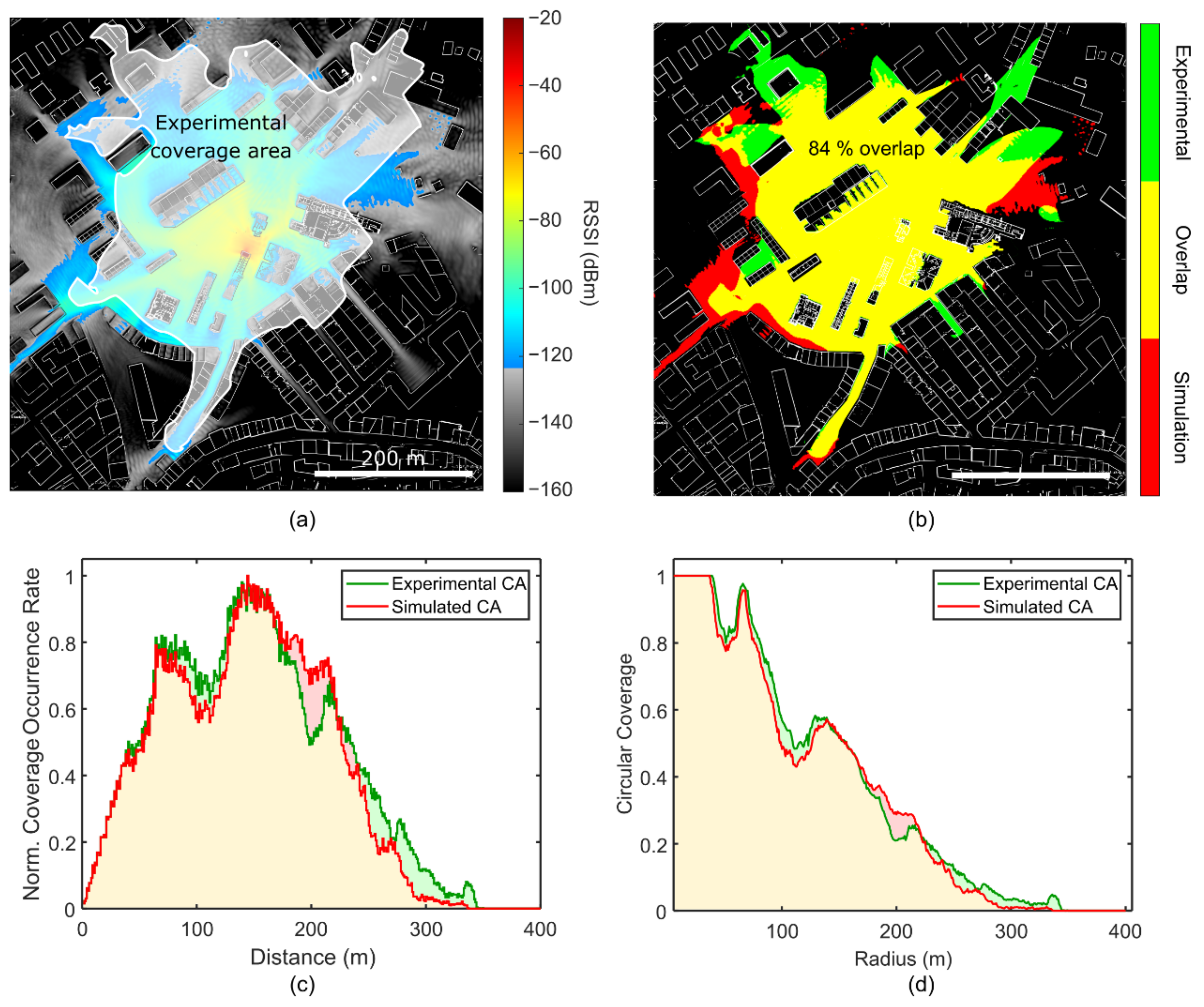
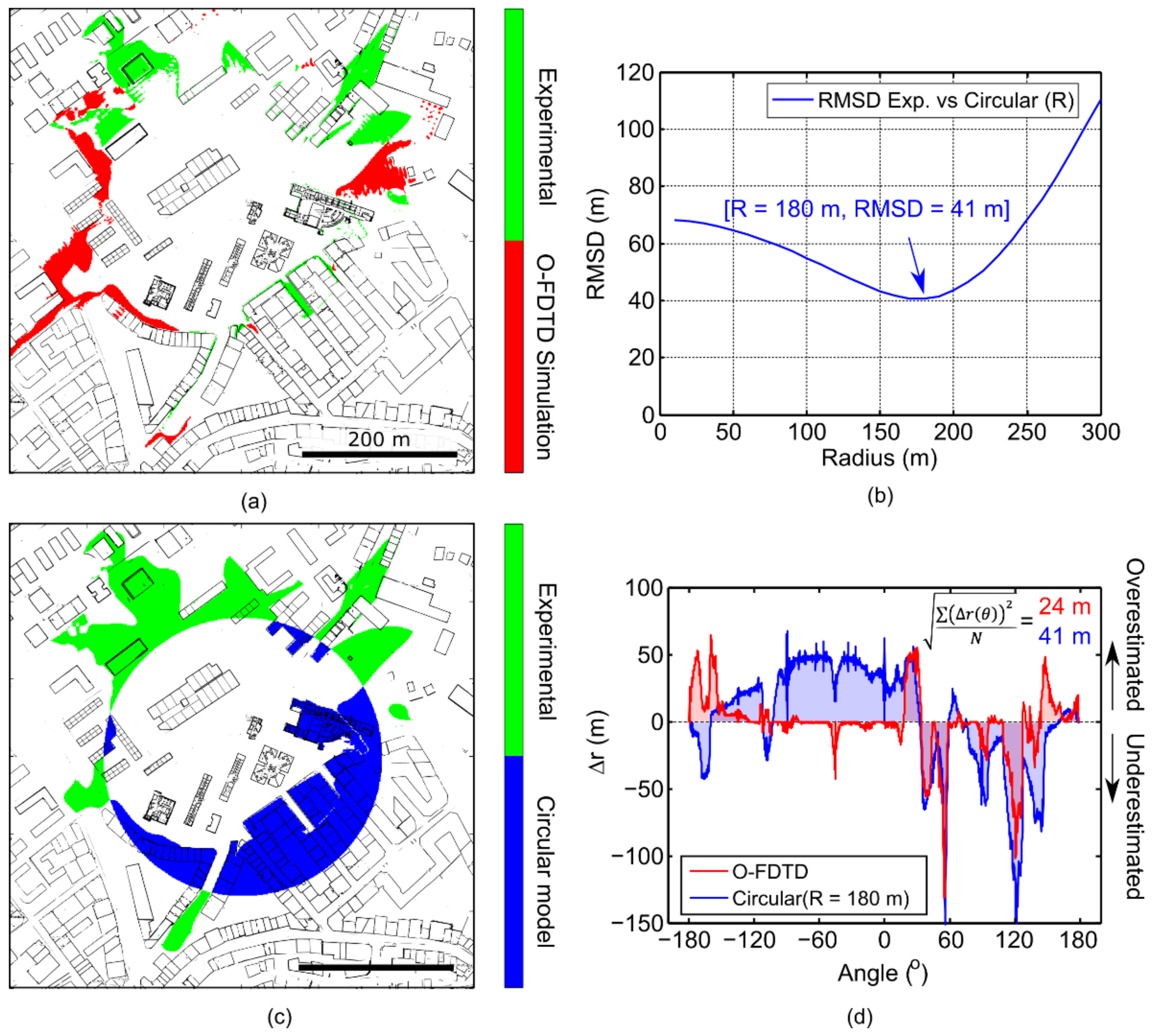
| θ0 [rad] | R0 [m] |
|---|---|
| GTx [dBm] | λ [m] | dx [m] | nair | nwall |
|---|---|---|---|---|
| +20 | 0.345 | 0.0862 | 1 | 2.5 + i0.316 * |
| f | BW | SF | S/N | NF | GTx |
|---|---|---|---|---|---|
| 868 MHz | 125 KHz | 7 | −7.5 dB 1 | 6 dB 2 | +20 dBm |
Publisher’s Note: MDPI stays neutral with regard to jurisdictional claims in published maps and institutional affiliations. |
© 2021 by the authors. Licensee MDPI, Basel, Switzerland. This article is an open access article distributed under the terms and conditions of the Creative Commons Attribution (CC BY) license (https://creativecommons.org/licenses/by/4.0/).
Share and Cite
Adão, R.M.R.; Balvís, E.; Carpentier, A.V.; Michinel, H.; Nieder, J.B. Cityscape LoRa Signal Propagation Predicted and Tested Using Real-World Building-Data Based O-FDTD Simulations and Experimental Characterization. Sensors 2021, 21, 2717. https://doi.org/10.3390/s21082717
Adão RMR, Balvís E, Carpentier AV, Michinel H, Nieder JB. Cityscape LoRa Signal Propagation Predicted and Tested Using Real-World Building-Data Based O-FDTD Simulations and Experimental Characterization. Sensors. 2021; 21(8):2717. https://doi.org/10.3390/s21082717
Chicago/Turabian StyleAdão, Ricardo M. R., Eduardo Balvís, Alicia V. Carpentier, Humberto Michinel, and Jana B. Nieder. 2021. "Cityscape LoRa Signal Propagation Predicted and Tested Using Real-World Building-Data Based O-FDTD Simulations and Experimental Characterization" Sensors 21, no. 8: 2717. https://doi.org/10.3390/s21082717
APA StyleAdão, R. M. R., Balvís, E., Carpentier, A. V., Michinel, H., & Nieder, J. B. (2021). Cityscape LoRa Signal Propagation Predicted and Tested Using Real-World Building-Data Based O-FDTD Simulations and Experimental Characterization. Sensors, 21(8), 2717. https://doi.org/10.3390/s21082717







